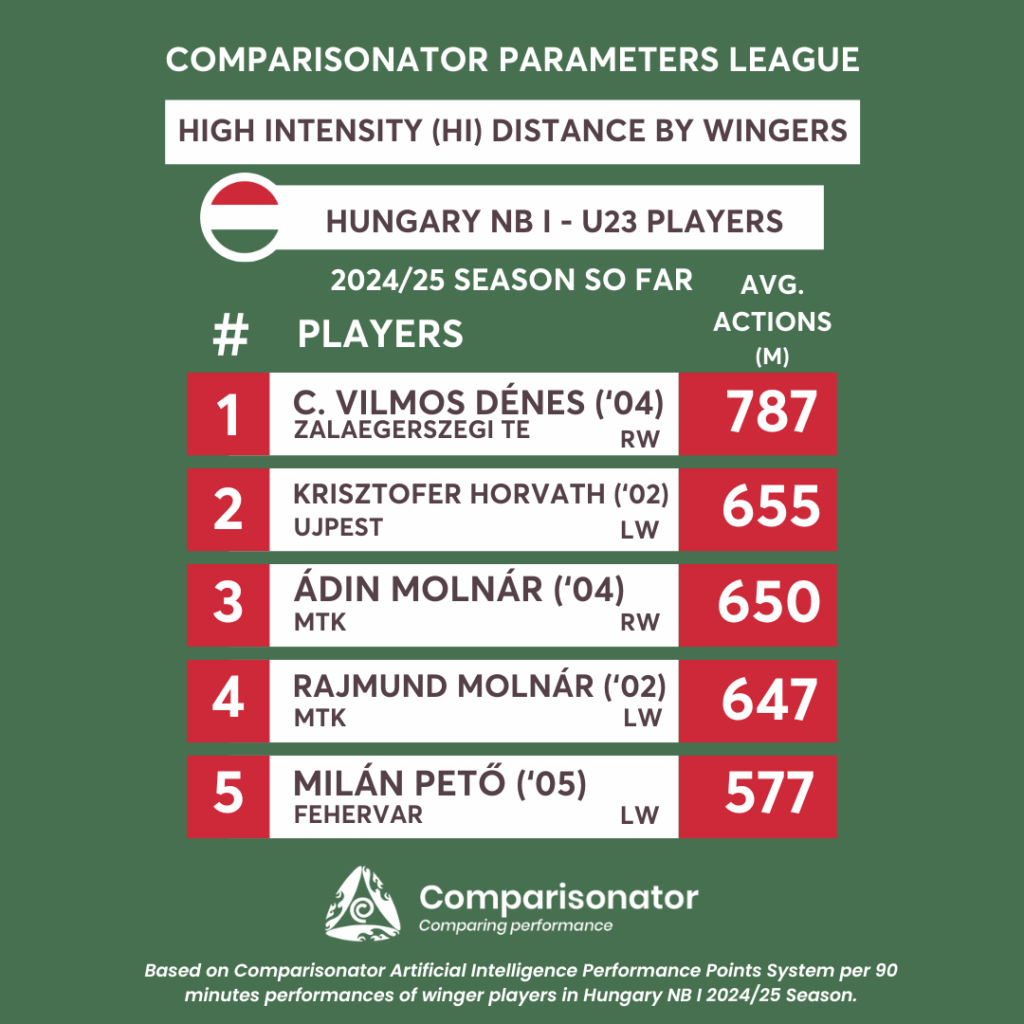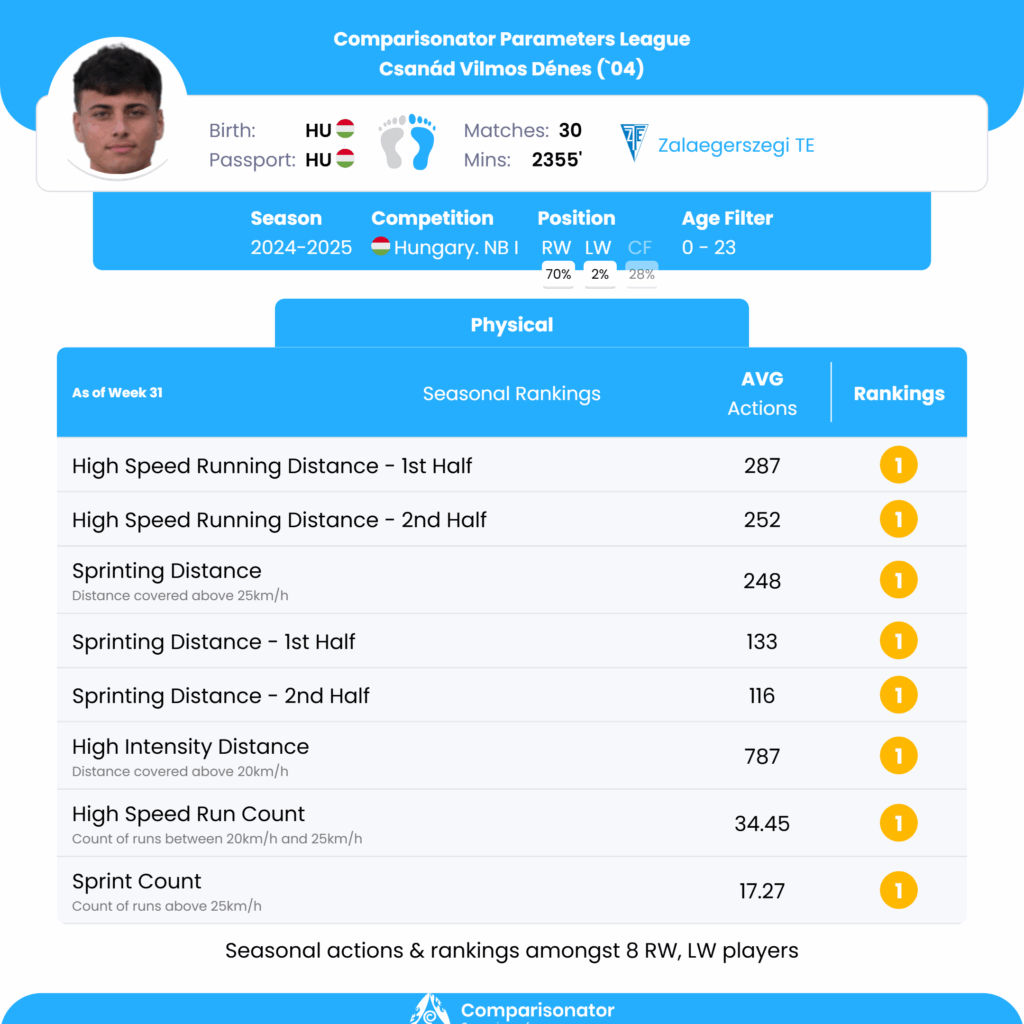As the demands of modern football continue to rise, physical intensity has become a defining factor in identifying top-level talent. Leveraging the advanced capabilities of the Comparisonator Physical Data Comparison Module, we’ve analyzed Hungary’s NB I league to spotlight the top-performing U23 players in three key physical metrics during the 2024/25 season so far. This comprehensive assessment offers clubs, scouts, and analysts valuable insight into emerging players whose physical performance sets them apart.
These findings underscore the increasing significance of physical data in contemporary scouting and recruitment. Extracted from broadcast footage using AI-driven analysis, the metrics provide clubs with accurate, contextualized benchmarks for evaluating talent.
In the Sprinting Distance category—tracking distance covered at speeds over 25 km/h—Ákos Markgráf emerges as the leader, demonstrating sustained pace in high-intensity match scenarios. Márk Kosznovszky leads in Running Distance, highlighting his exceptional endurance and relentless work rate across full matches. Meanwhile, Csanád Vilmos Dénes tops the charts in High Intensity Distance, showcasing frequent bursts at speeds exceeding 20 km/h, a testament to his explosiveness and mobility.
These standout performances not only spotlight Hungary’s next generation of talent but also illustrate how physical analytics can drive smarter, more informed football decisions—from unearthing hidden gems to building dynamic, high-performing squads. Stay tuned as we continue to reveal more data-driven insights throughout the season.
Please note that all numbers are per 90 min data from the 2024/25 Season – So Far.
Ákos Markgráf’s CompaGPT Physicals report:
Ákos Markgráf leads the LB position in Sprinting Distance, averaging 167.01 meters per match, surpassing Patrik Kovács who averages 166.15 meters. This indicates Markgráf’s high capability in covering ground rapidly, which can be tactically significant for pressing opponents and supporting offensive transitions. Markgráf excels in the first half, averaging 98.92 meters in Sprinting Distance, outperforming Marcell Berki’s 85.04 meters. This suggests a strong initial burst of energy and commitment, which can be strategically utilized for aggressive starts to matches, potentially unsettling opponents early on. Achieving a max speed of 34.16 km/h, Markgráf ranks second, just behind Botond Vajda at 35.07 km/h. This demonstrates his ability to reach high speeds, useful for chasing down opponents or making quick offensive runs.
Ákos Markgráf’s most notable performance metrics include leading rankings in Sprinting Distance and Sprinting Distance – 1st Half, demonstrating strong initial energy and speed capabilities. However, areas such as High Speed Running Distance and second-half endurance present opportunities for improvement, which could further bolster his overall game impact and consistency.
Ákos Markgráf (’05) (LB) – Puskas FC

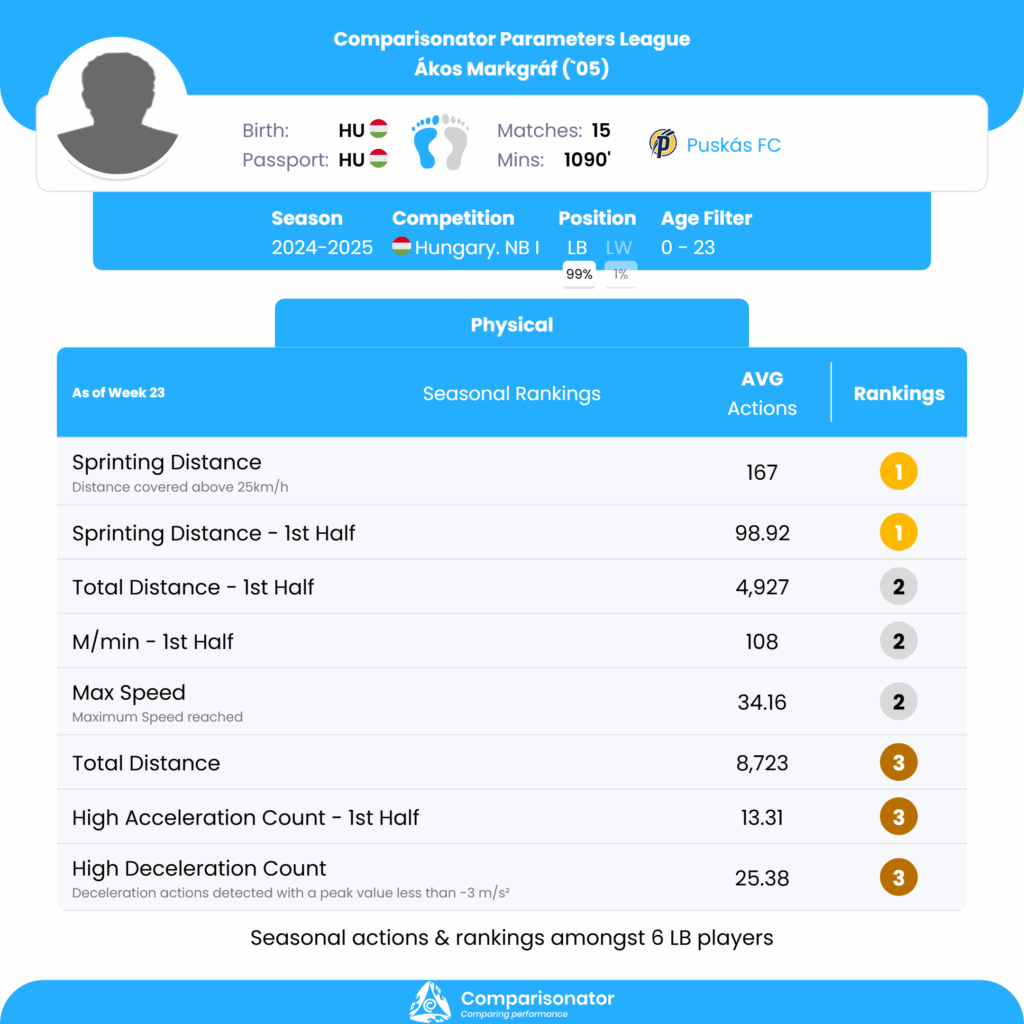
Sprinting Distance
Márk Kosznovszky’s CompaGPT Physicals report:
Márk Kosznovszky has a remarkable average of 10,923.37 meters per match in total distance covered, ranking 1st out of 14 players. This is superior to Mihály Kata, who covers 10,784.53 meters. This indicates Kosznovszky’s exceptional stamina and work rate on the field, crucial for maintaining midfield dominance and supporting both defensive and offensive plays. With an impressive average of 1,983.67 meters per match, Kosznovszky ranks 1st, showcasing his capability to cover large areas of the pitch, which aids in his roles as CMF and DMF, allowing him to support both defensive duties and attacking transitions. Kosznovszky also leads in high-intensity distance, averaging 898.81 meters per match, which is a testament to his ability to sustain high-energy performances throughout the match, essential for breaking opponent lines and supporting both ends of the pitch.
Márk Kosznovszky’s most notable strengths lie in his exceptional distance covering abilities across various metrics, including total distance, running distance, and high-intensity efforts, positioning him as a top performer in maintaining a high work rate and impacting the game across both halves. His ability to cover ground effectively supports his midfield roles, enabling defensive stability and offensive support. However, his lower ranking in max speed suggests a tactical approach that may rely less on outright sprinting and more on sustained efforts and positioning. Addressing his sprinting capabilities, particularly in the second half, might enhance his overall contribution and adaptability in high-pressure situations
Márk Kosznovszky (’02) (CMF) – MTK
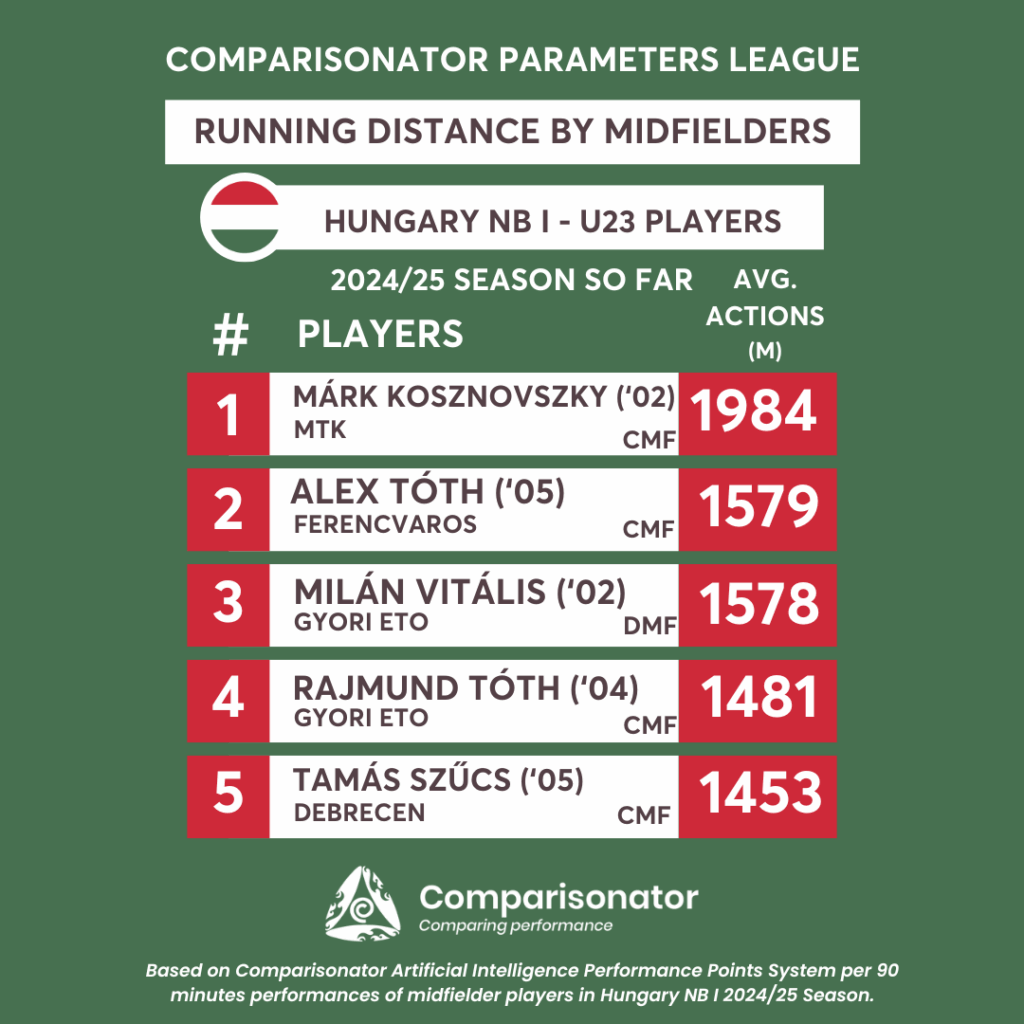
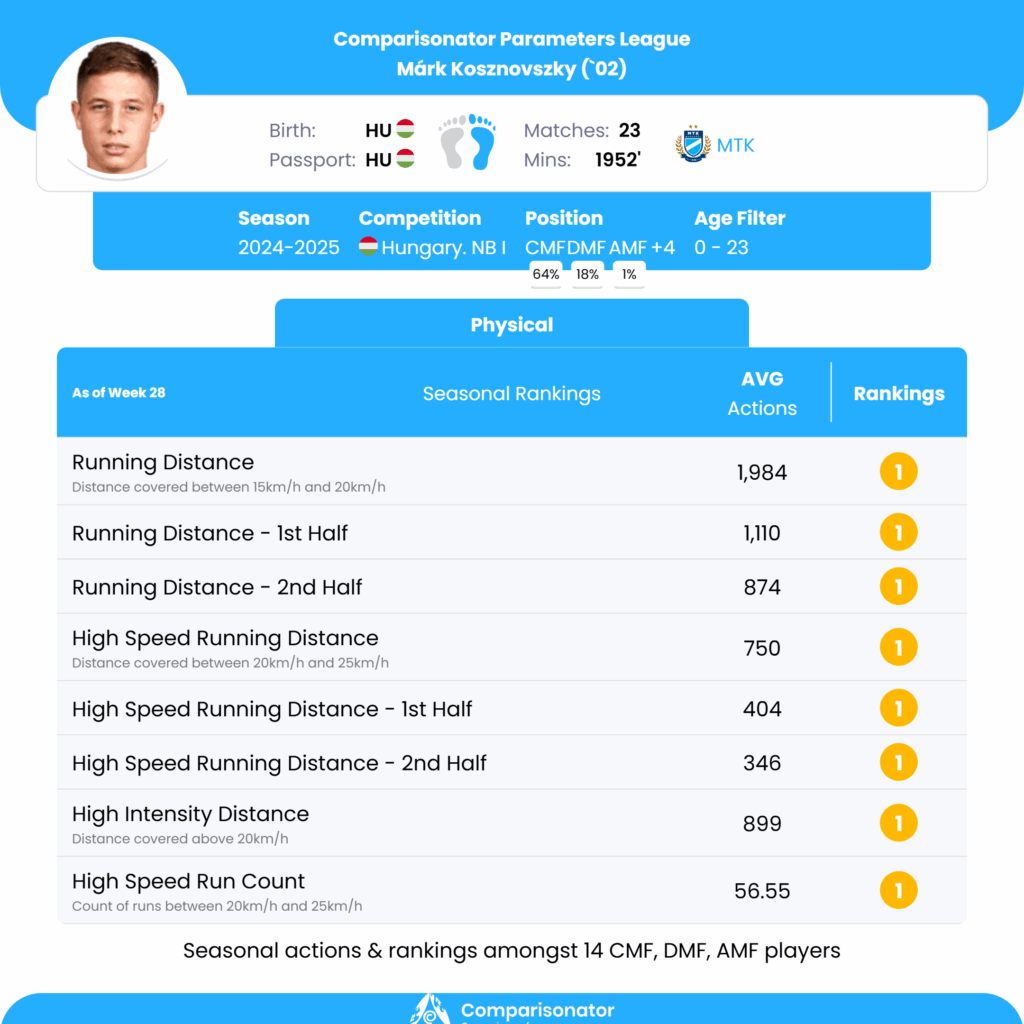
Running Distance
Csanád Vilmos Dénes’s CompaGPT Physicals report:
Csanád Vilmos Dénes has a top ranking in High Intensity Distance with 783.99 meters, significantly above Ádin Molnár’s 650.28 meters. This reflects his ability to perform under intense physical demands, indicating resilience and endurance in high-pressure situations. He can be strategically used in roles requiring sustained effort over extended periods. With an average of 536.65 meters per match, Csanád Vilmos Dénes ranks first, ahead of Rajmund Molnár at 461.7 meters. This suggests exceptional pace and ability to maintain high-speed runs, useful for breaking defensive lines and creating opportunities in fast-paced transitions. His speed can be tactically utilized to exploit spaces behind defenses. Leading with 24.57 counts per match, he surpasses Ádin Molnár at 24.06 counts. This highlights his explosive acceleration capabilities, crucial for quick changes of pace and direction, enabling effective dribbling and pressing. His acceleration can be leveraged to destabilize opponents and gain positional advantages.
Csanád Vilmos Dénes excels in several key Physical parameters, such as Total Distance, High Speed Running Distance, High Acceleration Count, High Intensity Distance, and Sprinting Distance, all highlighting his robust physical attributes and tactical versatility. These strengths make him particularly effective in dynamic roles requiring high endurance and speed. However, there are opportunities for improvement in his average work rate and maximum speed, which could further enhance his overall performance and utility in various tactical setups.
Csanád Vilmos Dénes (’04) (RW) – Zalaegerszegi TE
